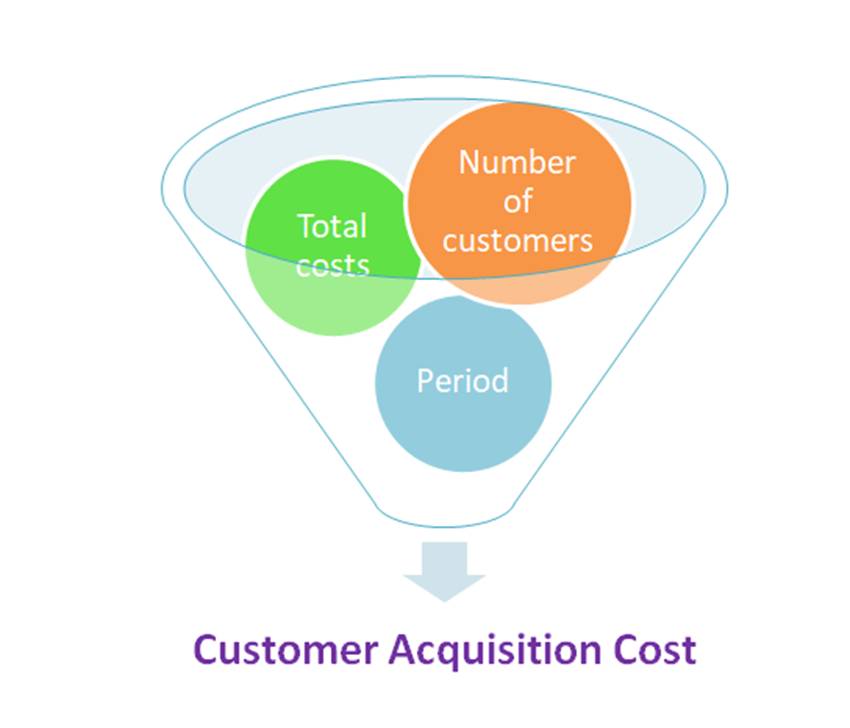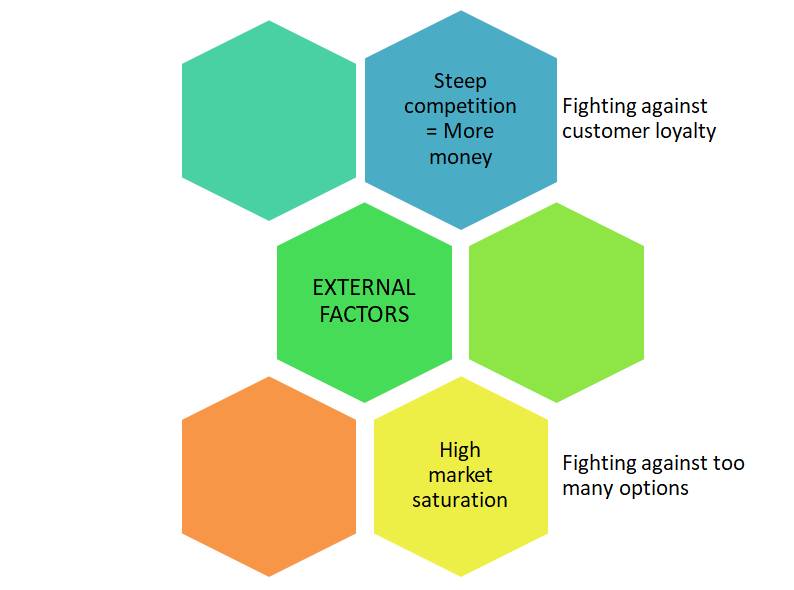It’s obvious you can’t have a business without clients.
But that doesn’t mean you should let your customer acquisition cost drain your profits.
The solution is understanding the exact figures and how to trim them down.
And you’re on the right page for that. We’ll discuss:
- How to calculate and analyze your CAC accurately
- Neat customer acquisition cost examples
- 7 Actionable steps to cut down CAC to optimize your ROI
Let’s get straight to it.
What Is Customer Acquisition Cost?
Customer acquisition cost (CAC) is a growth metric that defines the amount of money your business spends for each potential customer to purchase your product.
Therefore, CAC gauges how efficient your sales process is, measuring your overall profitability.
- Low customer acquisition costs: Entail a good business model and sales process. After all, you’re spending less to gain more.
- High customer acquisition costs: Your business model, sales process, or marketing strategies could be improved because you’re paying too much for too little.
To solve top customer acquisition challenges, let’s look at what goes into calculating CAC.
How to Calculate Customer Acquisition Cost
To determine your customer acquisition cost, use this basic formula: Customer Acquisition Cost equals the total expenses during a certain period divided by the total new customers gained in that period.
Here’s the customer acquisition cost formula in a nutshell:
CAC = Total cost of acquiring new customers/ Number of customers acquired
But while calculating customer acquisition costs seems simple, it’s definitely not easy.

There are three variables to consider in this CAC formula:
- Total sales and marketing costs
- Period
- Number of new customers
The number of new customers is the easiest variable to quantify.
But you have two more issues to consider:
- Total cost: If you don’t assess all the expenses comprising the total cost of your customer acquisition efforts, you might end up with a lower CAC than in reality. And that means you can’t make the necessary changes to decrease your cost per customer acquisition.
- Period of time: The customer acquisition cost calculation changes significantly if you take the long-term view. That’s why it’s important to understand how CAC relates to customer lifetime value (CLV).
Let’s review these issues below.
Total Costs: What Goes Into Your CAC Calculation?
Let’s jump straight into it.
Include all sales and marketing expenses, from how much you pay your teams to how much you pay for each marketing tool.
Why?
Because your goal is to optimize your profitability. After you understand all the expenses behind your initial investment, you can:
- Gauge the precise ROI for each customer acquisition channel and pinpoint the most cost-effective ones.
- Optimize your marketing and sales strategies.

So, you don’t want to miss any hidden expenses behind your costs of customer acquisition.
Sales and marketing costs include:
- Social media marketing
- Paid advertising costs
- Content marketing
- Events
- Sponsorships
- Employee salaries (including commissions and bonuses) for your sales and marketing team
- Outsourced lead generation services
- Customer relationship management (CRM) platforms
- Marketing automation tools
- Overhead costs, such as rent, utilities, business licenses, and more
- Analytics platforms
- Other sales and marketing optimization software
Warning: These variables are affected by internal and external variables.
External Factors
External factors that affect the cost per customer acquisition include:

- Your competition: If your business operates in a competitive niche, you must spend more money on your sales team, software tools, and marketing. That’s because you need to invest more to stand apart from your rivals.
- Market saturation: This variable defines the degree to which the market is filled with similar products and services. A higher market saturation entails including more (or higher) costs into your customer acquisition cost formula. That’s because people have too many options to choose from.
Internal FactorsYour customer acquisition costs may be influenced from the inside. Here are some variables to consider:

- Your pricing strategies: If your price packages are too high, you may attract fewer customers, translating into a higher CAC. Therefore, you must tweak those packages for different customer segments.
- Your overall customer retention strategy: Let’s say you offer a low starting price to hook new customers, but increase your fees in the long run. In this case, the average customer will give up your products or subscriptions to your company, advising other prospects to avoid your brand. A bad reputation makes it harder to attract new customers, thus leading to increased CAC.
- Your customer communication: You may spend heaps of money to develop intricate marketing funnels, SEO strategies, or sales pitches for lead generation. But if you don’t follow up with qualified leads, all this money will be spent in vain, thus increasing overall CAC.
- Your employee turnover: If your company gains a negative reputation, which causes you to lose money and investors, your solid employees will change jobs. Thus, you’ll need to invest more in building and shaping a new sales team.
Get the most out of your paid media with inBeat TikTok Ads Agency
CAC Period: How CAC Relates to CLV
Let’s say you have a CAC of $25. Is that good or not?
The answer is that it depends.
If that customer for whom you paid $25 makes one purchase and brings you a lifetime value of $10, your CAC is exorbitant.
If the same customer brings you a $3, 000 ROI over multiple purchases, the same $25 CAC can be considered low.
Let’s analyze two examples.
Example 1:
Imagine a subscription-based music streaming service. The company invests $500, 000 in advertising for a month and successfully gains 50, 000 new subscribers. The CAC here is $10. On the surface, that might seem like a minor expense, especially when subscribers are paying $7.99 per month for the service.
But what if most of your current customers use the service’s free trial for one month and then cancel? The CLV for many of these users will be $0.
If, however, a segment of those subscribers stays with the service for an average of 2 years, the CLV for those subscribers would be approximately $191.76 (24 months x $7.99). So, spending $10 to acquire a customer that brings in nearly $192 over their lifetime is a fantastic deal.
Example 2:
Now consider a local fitness gym. It spends $200, 000 on promotional activities, including discounts, free trials, and advertising to attract 2, 000 new members, translating to a CAC of $100.
Members pay a monthly fee of $50. If the average member sticks around for just 2 months, the CLV is $100, merely breaking even with the CAC. But, once adopted, gym memberships often become longer-term commitments due to motivation, routine, or even contractual agreements.
Suppose the average member stays loyal to the gym for 1 year. In that case, the CLV becomes $600 (12 months x $50), making that initial $100 CAC a wise investment.
Lesson learned: While acquiring customers is essential, retaining them for longer time periods enhances their lifetime value, making your initial acquisition costs more justifiable. So, if you want to flourish your online store, you need to constantly improve the eCommerce CAC strategy as well as monitor the CLV-to-CAC ratio.
Why Is CAC Important?
If you read so far, you may intuit that knowing your customer acquisition costs is the backbone of improving your profitability and future success.
And this metric is essential for early-stage investors who assess your net margins.
If your company looks successful and profitable, you will attract more partners to support its growth.
That brings us to the next point.
7 Ways to Reduce CAC
If you want to compare your organic or paid customer acquisition results and decrease the budget spent, you must:
- Optimize the expenses behind your customer acquisition costs: Consider all the marketing channels and tactics you use in marketing and sales. Zero in on the winning ones.
- Decrease the payback period: CAC is an expense your business incurs. Your job is to retrieve that cost fast, meaning you must improve customer retention, as well as upselling and cross-selling strategies.
- Factor in your CLV: CLV is an important business metric alongside CAC. As a rule of thumb, aim for a CLV to CAC ratio of at least 3.
Here are seven practical ways to do that:
- Optimize ad spend: Regularly review your advertising campaigns to zero in on the best strategies, hooks, and even colors. Use creative testing to see which ads, channels, or social media influencers yield the highest conversion rates. Divert your budget accordingly to optimize your marketing efforts.
- Leverage user-generated content (UGC): Encourage your customers to create and share content about your products or services. Reviews, testimonials, unboxing videos, or social media posts are organic endorsements, driving trust and new customers without significant spending. Plus, we have successfully used UGC to reduce ad fatigue.
- Use micro-influencer marketing: Power up your pillars of customer acquisition strategy with engaged micro-influencers rather than targeting influencers with huge followings. Basically, you’re shooting two birds with one stone because micro-influencers are cost-effective, but their connection with their audiences leads to higher conversion rates. And that’s how you optimize your marketing spend.
- Improve onboarding and user experience: A smooth and intuitive customer journey can improve conversion rates. Thus, you get fewer drop-offs and a lower customer acquisition cost.
- Connect with your audience: Explain how your products and services work so customers can choose wisely and remain loyal to your brand. Use product comparisons, answer all their questions, and provide solid customer support. Nurture your audience with email marketing campaigns or follow-up phone calls, depending on your business model. And always consider their feedback to refine your products and strategies.
- Use retargeting campaigns: It’s often more cost-effective to retarget visitors who’ve already interacted with your website but have yet to convert. Use retargeting ads to remind these potential customers about your offerings.
- Invest in SEO: Optimizing your website for search engines ensures a higher ranking in search results. That means more potential customers will see your website and possibly convert. Besides, organic search traffic is more value-for-money than paid ads. And it can bring in a significant portion of new customers.
How to Optimize Your ROI with Lower CAC
A deep understanding of your customer acquisition metrics helps you optimize your budget and skyrocket your ROI.
This article explained how to calculate customer acquisition costs and seven ways to balance them with the customer’s lifetime value.
And they work.
But finding the precise mix of strategies can be tough if you lack the expertise.
inBeat Agency can help.
We have successfully used UGC, micro-influencer marketing, and a slew of non-conventional techniques to decrease CAC significantly for countless clients.
In NielsenIQ’s case, a mix of TikTok UGC ads decreased consumer fatigue and slashed CPAs by 75% across all channels.
We can take the same data-driven, results-focused approach with your company.
Book a free strategy call, and we’ll discuss customized solutions that fit your company.
Want more examples of successful influencer marketing strategies? Check out our case studies.
Want more examples of successful UGC campaigns? Check out case studies of our performance-based UGC agency!

